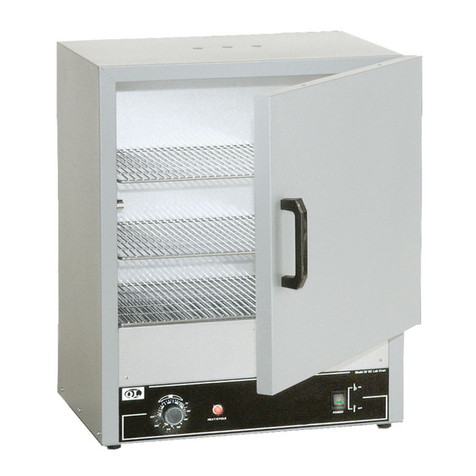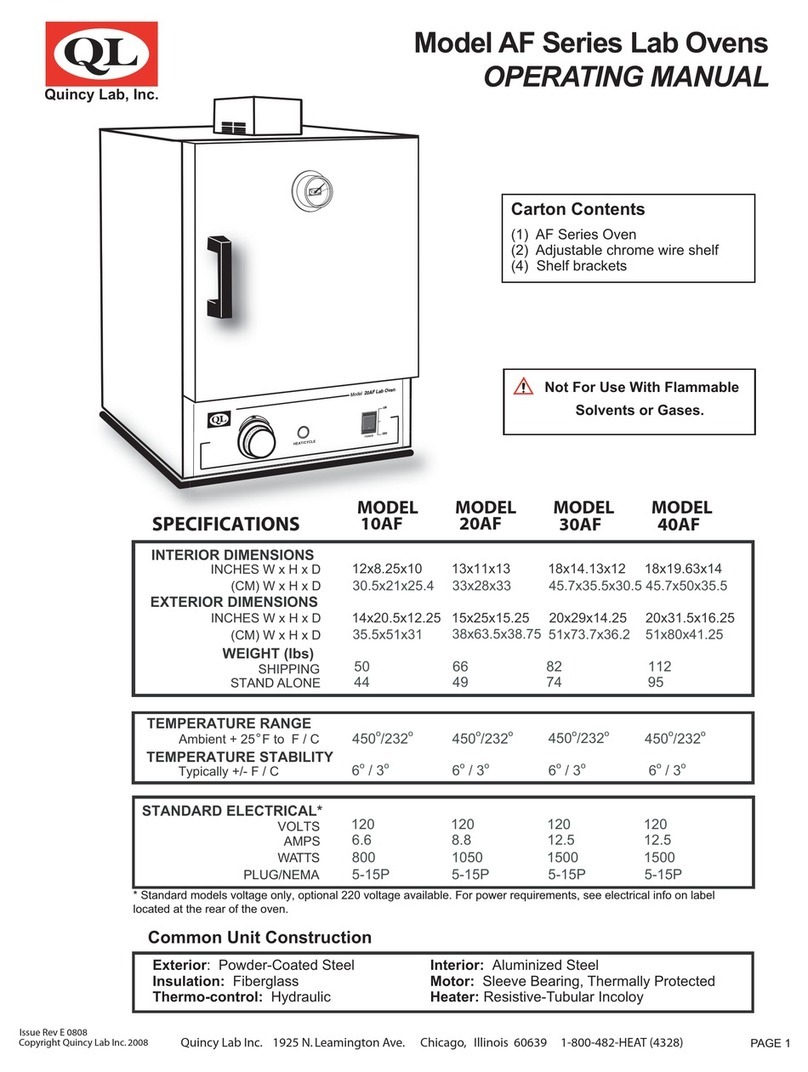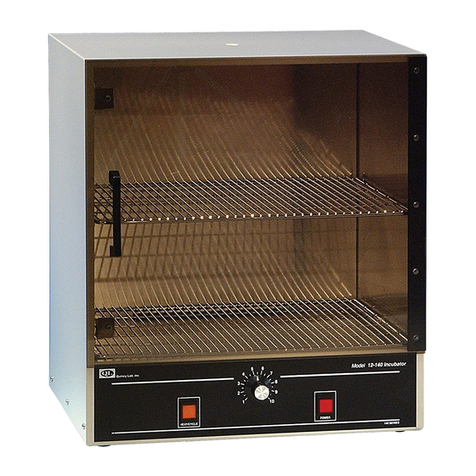
PAGE 2
A B
C D
FIG. 1
FIG. 2
Set-up
Position unit in its ultimate operating location. Keep a minimum of
2" of airspace around the unit and a minimum of 10" above the
unit. The port holes at the top of the unit will expel a small amount
of warm air through natural convection. This port can also be used
as an access for an external temperature probe to verify the
chamber's temperature or the chamber's contents directly.
Install adjustable shelf by placing the ends of the wire shelf bracket
into the corresponding holes located on the inner sides of the oven
at the desired height. Push the ends of the
bracket into the holes until the first bends in the bracket are
against the wall, then rotate the bracket down. Place the shelf on
the brackets. (FIG 1)
Plug the unit into a grounded outlet for your unit's rated voltage.
General Operation
The unit is ready for your immediate use. All control parameters,
calibration and tuning has been done at the factory, no adjustments
are necessary.
Push the illuminated power button. All LED's on the temperature
control will light-up and display the current chamber temperature
and the set temperature.
Set temperature is constantly displayed in the lower right-hand
corner of the display. To change the set temperature, simply press
either the up arrow key or the down arrow key, until desired set
temperature is reached. (FIG. 2) The temperature control is set at
the factory to read in 1/10th degree F, or Fahrenheit units.
To change Controller functions see: Menu Level Functions Guide
Read Operating Instructions Thoroughly Prior to Operation
The GCE Series lab ovens are not designed for use with any flammable solvents or gases or for materials
that may contain flammable solvents or gases. Use only a grounded outlet that is rated for your model's
electrical requirement. Oven exterior walls and doors may become hot to the touch when operating at higher
set temperatures. Do not leave the oven unattended during operation, especially when processing materials
that have flash point temperatures lower than the model oven's maximum operating range. Do not modify the
oven or control parameters to operate the oven above the stated maximum operating temperature.
Safety Precautions
Once the unit nears the desired temperature allow the unit to cycle for 20 minutes at set point before temperature
becomes fully stable. NOTE: Upon each initial powering-up, the control may typically overshoot the set temp by 3 or 4
degrees especially if the temperature set point is close to the operating ambient temperature. After equilibrium is
achieved the control will hold set temperature within 1 unit degree.
READ INSTRUCTIONS THOROUGHLY BEFORE OPERATING OVEN
DO NOT USE WITH FLAMMABLE LIQUIDS OR GASES
EXTERIOR SURFACES MAY BECOME HOT DURING OPERATION
WARNING:
WARNING:
CAUTION:
RISK OF ELECTRICAL SHOCK. DISCONNECT UNIT FROM POWER SOURCE BEFORE REMOVING COVER
WARNING:
NOT FOR USE WITH OPEN LIQUIDS
WARNING:
CARE SHOULD BE TAKEN WHEN CARRYING/LIFTING UNIT INTO PLACE. LARGER
UNITS ARE HEAVY AND MAY REQUIRE TWO PEOPLE TO TRANSPORT OR INSTALL.
WARNING:
Unit Safety Reset- If the unit exceeds its maximum temperature, an internal safety “snap disc” will cut power to the
unit until it is manually reset. To do this, unplug the unit, lay it on its back and remove the bottom cover. Locate the round
safety “snap disc” and push in the button to reset.
RISK OF ELECTRICAL SHOCK. DISCONNECT UNIT FROM POWER SOURCE BEFORE REMOVING COVER.
FAILURE TO COMPLY COULD RESULT IN SERIOUS INJURY OR DEATH.
WARNING:
(page 3).


























